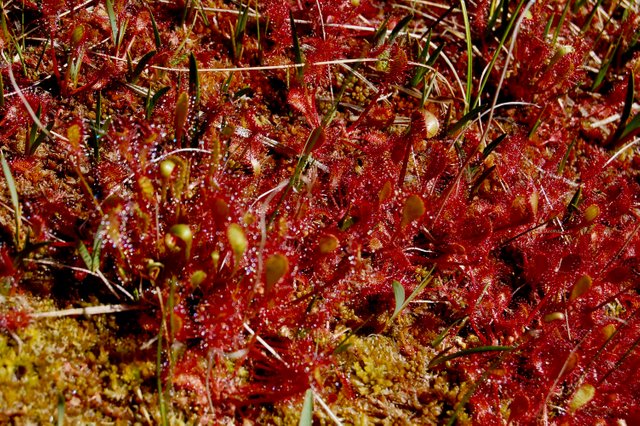Colourful insect-eating marsh plant
The Sundew family there are three species that are common in Norway.
The three species are Round-leaved sundew (Drosera rotundifolia), English sundew or Great sundew (Drosera anglica) and Spoonleaf sundew (Drosera intermedia).
These plants are quite similar and can be difficult to distinguish for most people, leaving behind the particular species of botanists.
Nevertheless, I mean the depicted species to be Spoonleaf sundew (Drosera intermedia).
It is not Round-leaved sundew because they are almost entirely round in the leaf shape.
Both English sundew and Spoonleaf sundew have elongated leaves.
What distinguishes these two species is the length of the leaves, where English sundew has longer leaves than Spoonleaf sundew. This sundew is not so long, and therefore I believe it can be Spoonleaf sundew. If anyone can determine the species only from the pictures, they just have to correct this.
What is interesting about these plants, however, is that they eat insects.
On the leaves, there are glossy mucus drops. If the insect goes over these, they hang, and the sunflower plant can then roll the sheet around the insect and digest it.
If you find this plant interesting, you can read more about it here:
https://en.wikipedia.org/wiki/Drosera


That's very interesting. Thank you for their detailed description.
I have never seen such plants in our country.
It would be very interesting to see them :-)
Very interesting about them is written in the link you provided.
I Read with pleasure :-)
Thanks for the pictures. They have an unusual bright shade.
It's nice that you find the article interesting @Singa
Insect-eating plants have fascinated me since I was a little boy learned about these plants.
There are also a few other insectivorous plants in Norway. One of them is Butterwort (Pinguicula vulgaris) and the third one is Floating Bladderwort (Utricularia gibba) which is an aquatic plant.
I've never heard of them before. Thanks for telling me!
Carnivorous plants, it is always interesting. A predator, it is always associated with the mind, which means that these plants are not just amorphous creatures, they have movement. You gave me a good motivation to go to the swamps in the summer and look for dews. I read about them, but, I have not met them in nature. They have a lot of medicinal properties, which, before, I did not guess. Thank you for the photos! Does red indicate that this plant does not need chlorophyll?
We have a common interest in Carnivorous plants @Barski
Such plants already fascinated me as a little boy.
Nice that you liked the pictures of sundew. In my comment above, I have mentioned a few other Carnivorous plants that grow in Norway. The two who live on the land I know well.
The last Carnivorous plant that lives in water is less familiar to me.
)) We have with you a passion for plants began in childhood. I was interested in all the plants. At the age of 7 I already collected medicinal herbs, dried them and handed them over to the pharmacy. I was always interested to know the properties of plants. Sometimes, we have a real treasure under our feet, if you don’t have knowledge, you can walk past your Eldorado))
Marsh planet so beautiful i liked this red color
You are great photographer